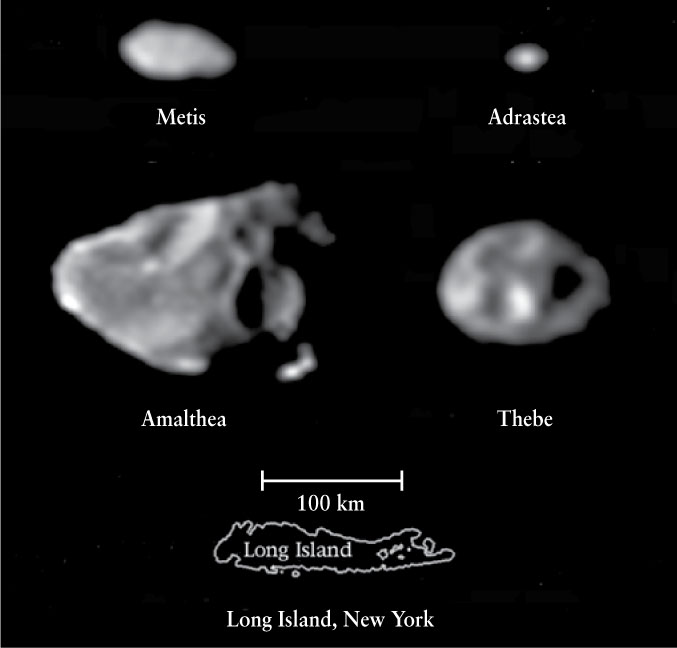13-9 Jupiter has dozens of small satellites that have different origins

Jupiter’s Four Inner Satellites First observed in 1892, Amalthea was the last satellite of any planet to be discovered without the aid of photography. Metis, Adrastea, and Thebe, by contrast, are so small that they were not discovered until 1979. These images from the Galileo spacecraft are the first to show these three satellites as anything more than points of light.
Besides the four Galilean satellites, Jupiter has at least 63 other confirmed satellites (as of 2012). Each is named for a mythological character associated with Jupiter. Appendix 3 gives details of some of the satellites’ orbits. It is helpful to sort Jupiter’s satellites into three groups according to their sizes and orbits.
Four planet-sized satellites, Io, Europa, Ganymede, and Callisto, can be thought of as four of the terrestrial worlds of the solar system. All are comparable in size to the planet Mercury (see Table 13-1). The semimajor axes of their orbits range from 5.9 to 26 times the radius of Jupiter. (By comparison, the distance from Earth to the Moon is about 60 times Earth’s radius.)
Four small inner satellites, Metis, Adrastea, Amalthea, and Thebe, have orbital semimajor axes between 1.8 and 3.1 times the radius of Jupiter. As Figure 13-26 shows, these satellites have irregular shapes, much like a potato (or an asteroid). The largest of the inner satellites, Amalthea, measures about 270 by 150 km (170 by 95 mi)—about 10 times larger than the moons of Mars, but only about one-tenth the size of the Galilean satellites. At these small sizes, gravity is too weak to pull the moons into a spherical shape. Discovered in 1892, Amalthea has a distinct reddish color due to sulfur that Jupiter’s magnetosphere removed from Io’s volcanic plumes, then deposited onto Amalthea’s surface. The three other inner satellites are even smaller than Amalthea. They were first discovered in images from Voyager 1 and Voyager 2.
Fifty-nine small outer satellites have diameters from 184 km for the largest to about 1 km for the smallest. All orbit far beyond Callisto, with semimajor axes that range from about 100 to 360 times the radius of Jupiter. (Twenty-three of these satellites were discovered in 2003 alone, and even more may be discovered as telescope technology continues to evolve.)
Only a few of Jupiter’s satellites orbit the planet in the same direction as Jupiter rotates
The Galilean satellites and the four inner satellites all orbit Jupiter in the plane of the planet’s equator. (The same is true of Jupiter’s rings, discussed in Section 12-9.) Furthermore, these orbits are all prograde orbits, which means that these objects orbit Jupiter in the same direction as Jupiter’s rotation. We would expect orbits in the same direction if these satellites formed from the same primordial, rotating cloud as Jupiter itself. (In a similar way, the planets all orbit the Sun in nearly the same plane and in the same direction as the Sun’s rotation. As we saw in Section 8-4, this reinforces the idea that the Sun and planets formed from the same solar nebula.)
In contrast, the 59 outer satellites all circle Jupiter along orbits that are inclined at steep angles to the planet’s equatorial plane. These satellites are thought not to have formed along with Jupiter; rather, they are probably wayward asteroids captured by Jupiter’s powerful gravitational field. One piece of evidence for this is that most of the outer satellites are in retrograde orbits: They orbit Jupiter in a direction opposite the planet’s rotation. Calculations show that it is easier for Jupiter to capture a satellite into a retrograde orbit than a prograde one.
CONCEPT CHECK 13-12
Why does a retrograde orbit suggest that a moon is a captured asteroid?
If Jupiter formed like a mini solar system as expected, any moon that formed with Jupiter would have a prograde orbit (in the same directions as Jupiter’s rotation), and would also orbit approximately in Jupiter’s equatorial plane. The retrograde moons (orbiting in the direction opposite to Jupiter’s rotation at high inclinations to Jupiter’s equator) must have a different origin, and the capture of asteroids is most likely.